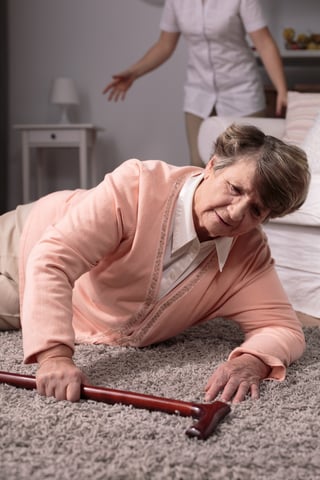 The numbers are clear: about one-third of adults, ages 65 years and older, will sustain a fall this year. And the statistics that relate to the cost of falls are equally concerning. Because falls are a substantial risk in senior living communities, we focus a lot of attention on asking why residents fall and what can we do to prevent them. The results from a recent study provides us with some answers.
The numbers are clear: about one-third of adults, ages 65 years and older, will sustain a fall this year. And the statistics that relate to the cost of falls are equally concerning. Because falls are a substantial risk in senior living communities, we focus a lot of attention on asking why residents fall and what can we do to prevent them. The results from a recent study provides us with some answers.
Study Shows What Causes Senior Falls
A 2014 observational study determined how and why falls occur in the aging population by actually videotaping falls in two long-term-care facilities between 2007 and 2010. The video cameras were placed in the common areas such as the dining rooms, hallways, and lounges. When a fall occurred it was reviewed with a focus on the actual cause of imbalance and the activity at the time of falling. The study captured 227 falls from 130 individuals. The researchers concluded that the most common cause of falls (41 percent) was incorrect weight shifting: basically, how an individual moves or transfers from one position to another.
Specifically, researchers noted that the majority of falls they recorded occurred in a position change from standing to walking. You see, staying balanced is about more than maintaining steady footing when in motion. The results of this study show that how we start moving can be much more crucial to staying in balance.
Weight-Shifting Exercises are Key to Fall Prevention
If the researchers are right, then we need to make sure our senior living fitness programs incorporate weight-shifting exercises for participants. Not only do these activities teach residents about how to understand their center of gravity, but they also help with coordination and provide opportunities for modest strength and endurance gains in the lower body muscles. When taught carefully, implementing weight-shifting exercise into a balance program can provide intentional focus on more precise movement which helps overall motor control.
Ideally, your community's fitness program is run by a qualified fitness professional who can provide a range of fitness services for seniors including customized exercises in group and individual settings for each resident's needs.
Fitness professionals can administer balance-training and weight-shifting exercises through one-on-one personal training sessions, group exercise classes, or with simple recommendations of exercises for a resident to include in her typical morning stretches. Trained staff can also provide field testing to help residents understand how they score on balance and other fitness tests so that they can work toward improvement with their tailored exercise regimen.
In case you don't have qualified staff on board, here are some examples of simple weight-shifting exercises for active older adults that can be taught by anyone in your community:
- Side Sways: While seated in a chair or standing, place the feet slightly wider than hip width apart. Leading with the upper body, lean the body gently to the right while keeping both feet in contact with the floor. Repeat 10 to 15 times in both directions. Watch a demo of the exercise.
- Forward Steps: Standing with the feet together near a chair back or counter top to hold onto, take an exaggerated step forward with the right foot. Then take the necessary amount of steps to recover to a normal standing position. Repeat 8 to 10 times and then perform on the left leg. Watch a demo of the exercise.
For more great content like this, download our whitepaper on balance and subscribe to our blog:




